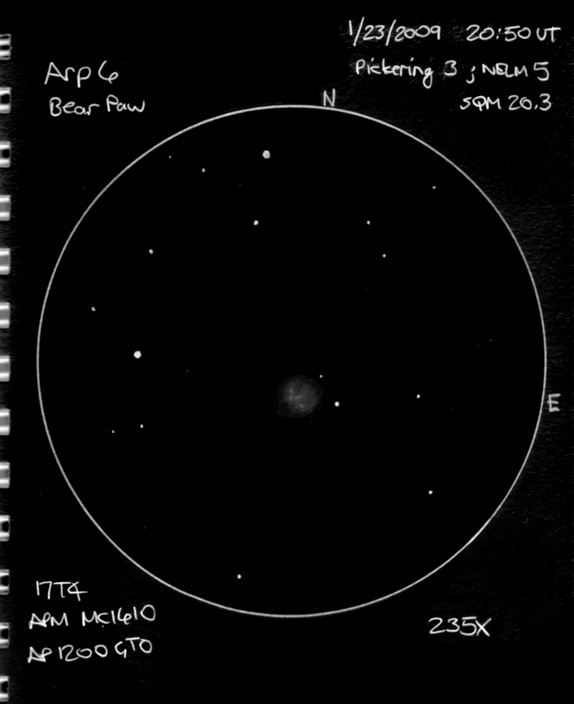
NGC 2537, the Bear’s Claw Galaxy
Sketch and Details by Jeff Young
I spent quite a bit of time viewing this one, trying as I might to eek out the bear-paw shape. In the end, I managed the 4 bright knots, but the dark lane which defines the paw eluded me. The rather poor seeing might have been in play here, although my transparency for the night wasn’t great either.
The Bear Paw’s unusual shape also contributed to its interesting history. William Herschel compared it to a planetary in his original (1787) observation: “… almost of an even light throughout, approaching to planetary, but ill defined and a little fainter on the edges…”. His son John, evidently having resolved some of the knots, thought it a globular cluster: “…very nearly uniformly B[right], but hazy at the edges. It is a resolved globular cluster. Being a remarkably fine night, I see the stars; they are 20th mag….” In the end, it took Lord Rosse’s 72” Leviathan and several observations during the late 1840’s and 1850’s to identifiy it as a “spiral nebula” (i.e.: galaxy).
Bear Paw Galaxy / Arp6 / NGC2537
Dwarf galaxy in Lynx
Sketched Jan 23, 2009 from County Louth, Ireland,
as viewed through 16” Mak-Cass @235X; Pickering 3, NELM 5, SQM 20.4
Daler-Rown ey HB Graphic pencil on white cartridge paper. Scanned and inverted in Photoshop.
Cheers,
— Jeff.

Jeff,
Excellent sketch and nice history lesson about this galaxy.
Frank 🙂
Jeff,
Very fine sketch. What about the rest of Lynx galaxies? Are You working on it? 😉
Marek
Jeff that is a fantastic capture & rendition. It appears to be becoming the norm that I follow you after viewing your inspirational drawings to exceptional objects.
Thank you, Dale
Marek —
I’m currently working through the Arps in a somewhat random order. I’ve got 15 observed so far, and 2 that I struck out on. There are still a lot to go…. 😉
— Jeff
Dale —
When you’re in the area, give Arp143 (NGC2444) a go. I think it might be beyond my reach, but I’ll give it another go when I’ve got better transparency.
Cheers,
— Jeff.
Jeff,
Nice drawing! Even with the less than ideal conditions you describe, you were able to observe and render enough detail to show that this is not a typical looking faint fuzzy.
Best,
Michael Rosolina
Friars Hill, WV USA